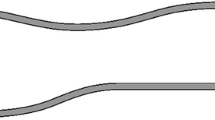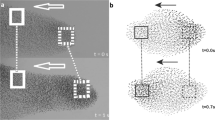Abstract
The coordinated motion of large flocks of starlings is fascinating for both laymen and scientists. During their aerial displays, the darkness of flocks often changes, for instance dark bands propagate through the flock (so-called agitation waves) and small or large parts of the flock darken. The causes of dark bands in agitation waves have recently been shown to depend on changes in orientation of birds relative to the observer rather than changes in density of the flock, but what causes other changes in darkness need to be studied still and this is the aim of the present investigation. Because we cannot empirically relate changes in darkness in flocks to quantities, such as position and orientation of the flock and of its members relative to the observer, we study this in a computational model. We use StarDisplay, a model of collective motion of starlings, because its flocks resemble empirical data in many properties, such as their three-dimensional shape, their manner of turning, the correlation of heading of its group-members, and its internal structure regarding density and stability of neighbors. We show that the change in darkness in the flocks perceived by an observer on the ground mostly depends on the observer’s distance to the flock and on the degree of exposure of the wing surface of flock members to the observer, and that darkness appears to decrease when birds roll during sharp turns. Remarkably, the darkness of the flock perceived by the observer was neither affected by the orientation of the flock relative to the observer nor by the density of the flock. Further studies are needed to investigate changes in darkness for flocks under predation.






Similar content being viewed by others
References
Attanasi, A., Cavagna, A., Del Castello, L., Giardina, I., Jelic, A., Melillo, S., Parisi, L., Pohl, O., Shen, E., & Viale, M. (2015). Emergence of collective changes in travel direction of starling flocks from individual birds’ fluctuations. Journal of the Royal Society Interface, 12(108), 20150319.
Axelsen, B. E., Anker-Nilssen, T., Fossum, P., Kvamme, C., & Nøttestad, L. (2001). Pretty patterns but a simple strategy: Predator-prey interactions between juvenile herring and Atlantic puffins observed with multibeam sonar. Canadian Journal of Zoology, 79(9), 1586–1596.
Ballerini, M., Cabibbo, N., Candelier, R., Cavagna, A., Cisbani, E., Giardina, I., Orlandi, A., Parisi, G., Procaccini, A., Viale, M., & Zdravkovic, V. (2008a). Empirical investigation of starling flocks: A benchmark study in collective animal behaviour. Animal Behaviour, 76(1), 201–215.
Ballerini, M., Cabibbo, N., Candelier, R., Cavagna, A., Cisbani, E., Giardina, I., Lecomte, V., Orlandi, A., Parisi, G., Procaccini, A., Viale, M., & Zdravkovic, V. (2008b). Interaction ruling animal collective behavior depends on topological rather than metric distance: Evidence from a field study. Proceedings of the National Academy of Sciences, 105(4), 1232–1237.
Bialek, W., Cavagna, A., Giardina, I., Mora, T., Silvestri, E., Viale, M., & Walczak, A. M. (2012). Statistical mechanics for natural flocks of birds. Proceedings of the National Academy of Sciences, 109(13), 4786–4791.
Bode, N. W., Franks, D. W., & Wood, A. J. (2011). Limited interactions in flocks: Relating model simulations to empirical data. Journal of the Royal Society Interface, 8(55), 301–304.
Carere, C., Montanino, S., Moreschini, F., Zoratto, F., Chiarotti, F., Santucci, D., & Alleva, E. (2009). Aerial flocking patterns of wintering starlings, Sturnus vulgaris, under different predation risk. Animal Behaviour, 77(1), 101–107.
Cavagna, A., Cimarelli, A., Giardina, I., Parisi, G., Santagati, R., Stefanini, F., & Viale, M. (2010). Scale-free correlations in starling flocks. Proceedings of the National Academy of Sciences, 107(26), 11865–11870.
Cavagna, A., Queirós, S. D., Giardina, I., Stefanini, F., & Viale, M. (2013). Diffusion of individual birds in starling flocks. Proceedings of the Royal Society B: Biological Sciences, 280(1756), 20122484.
Chaté, H., Ginelli, F., Grégoire, G., Peruani, F., & Raynaud, F. (2008). Modeling collective motion: Variations on the Vicsek model. The European Physical Journal B, 64(3–4), 451–456.
Cleveland Bent, A. (1927). Life histories of North American shore birds (No. 598.3397 C5). Dover Publications.
Cronin, T. W., Johnsen, S., Marshall, N. J., & Warrant, E. J. (2014). Visual ecology. Princeton University Press.
Davis, J. M. (1980). The coordinated aerobatics of dunlin flocks. Animal Behaviour, 28(3), 668–673.
Costanzo, A., & Hemelrijk, C. K. (2018). Spontaneous emergence of milling (vortex state) in a Vicsek-like model. Journal of Physics D: Applied Physics, 51(13), 134004.
Couzin, I. D., Krause, J., James, R., Ruxton, G. D., & Franks, N. R. (2002). Collective memory and spatial sorting in animal groups. Journal of Theoretical Biology, 218(1), 1–11.
Feare, C. J. (1984). The starling. Oxford University Press.
Gillies, J., Bacic, M., Thomas, A., Taylor, G., & Yuan, F. (2008). Modeling and identification of steppe eagle (Aquila nipalensis) dynamics. In: AIAA Modeling and Simulation Technologies Conference and Exhibit (p. 7096).
Hemelrijk, C. K., & Hildenbrandt, H. (2011). Some causes of the variable shape of flocks of birds. PloS one, 6(8), e22479.
Hemelrijk, C. K., & Hildenbrandt, H. (2012). Schools of fish and flocks of birds: Their shape and internal structure by self-organization. Interface Focus, 2(6), 726–737.
Hemelrijk, C. K., & Hildenbrandt, H. (2015). Diffusion and topological neighbours in flocks of starlings: Relating a model to empirical data. PLoS One, 10(5), e0126913.
Hemelrijk, C. K., & Hildenbrandt, H. (2015b). Scale-free correlations, influential neighbours and speed control in flocks of birds. Journal of Statistical Physics, 158(3), 563–578.
Hemelrijk, C. K., van Zuidam, L., & Hildenbrandt, H. (2015). What underlies waves of agitation in starling flocks. Behavioral Ecology and Sociobiology, 69(5), 755–764.
Hildenbrandt, H., Carere, C., & Hemelrijk, C. K. (2010). Self-organized aerial displays of thousands of starlings: A model. Behavioral Ecology, 21(6), 1349–1359.
Krause, J., Ruxton, G. D., Ruxton, G., & Ruxton, I. G. (2002). Living in groups. Oxford University Press.
Kunz, H., Züblin, T., & Hemelrijk, C. K. (2006). On prey grouping and predator confusion in artificial fish schools. In: Proceedings of the Tenth International Conference of Artificial Life. MIT Press, Cambridge, Massachusetts.
Nagy, M., Ákos, Z., Biro, D., & Vicsek, T. (2010). Hierarchical group dynamics in pigeon flocks. Nature, 464(7290), 890–893.
Pearce, D. J., Miller, A. M., Rowlands, G., & Turner, M. S. (2014). Role of projection in the control of bird flocks. Proceedings of the National Academy of Sciences, 111(29), 10422–10426.
Major, P. F., & Dill, L. M. (1978). The three-dimensional structure of airborne bird flocks. Behavioral Ecology and Sociobiology, 4(2), 111–122.
Procaccini, A., Orlandi, A., Cavagna, A., Giardina, I., Zoratto, F., Santucci, D., Chiarotti, F., Hemelrijk, C. K., Alleva, E., Parisi, G., & Carere, C. (2011). Propagating waves in starling, Sturnus vulgaris, flocks under predation. Animal Behaviour, 82(4), 759–765.
Pomeroy, H., & Heppner, F. (1992). Structure of turning in airborne rock dove (Columba livia) flocks. The Auk, 109(2), 256–267.
Potts, W. K. (1984). The chorus-line hypothesis of manoeuvre coordination in avian flocks. Nature, 309(5966), 344–345.
Storms, R. F., Carere, C., Zoratto, F., & Hemelrijk, C. K. (2019). Complex patterns of collective escape in starling flocks under predation. Behavioral Ecology and Sociobiology, 73(1), 10.
Strandburg-Peshkin, A., Twomey, C. R., Bode, N. W., Kao, A. B., Katz, Y., Ioannou, C. C., & Couzin, I. D. (2013). Visual sensory networks and effective information transfer in animal groups. Current Biology, 23(17), R709–R711.
Sumpter, D. J. (2010). Collective animal behavior. Princeton University Press.
Vicsek, T., & Zafeiris, A. (2012). Collective motion. Physics Reports, 517(3–4), 71–140.
Zoratto, F., Carere, C., Chiarotti, F., Santucci, D., & Alleva, E. (2010). Aerial hunting behaviour and predation success by peregrine falcons Falco peregrinus on starling flocks Sturnus vulgaris. Journal of Avian Biology, 41(4), 427–433.
Funding
This study was funded by NWO-TTW (Netherlands Organization for Scientific Research), Project nr 14723.
Author information
Authors and Affiliations
Corresponding author
Ethics declarations
Conflict of interest
The authors declare that they have no conflict of interest.
Ethical approval
This article does not contain any studies with human participants or animals performed by any of the authors.
Consent for publication
All author gave their consent.
Data availability
https://doi.org/10.6084/m9.figshare.8273549
Code availability
Available upon request.
Additional information
Publisher's Note
Springer Nature remains neutral with regard to jurisdictional claims in published maps and institutional affiliations.
Electronic supplementary material
Below is the link to the electronic supplementary material.
The video shows a flock of 5000 birds observed from the side. The centre of the roosting site is at position (0,0,0) and the observer is in position (100,0,0)
Appendix
Appendix
In the appendix we show additional graphs reporting the darkness as a function of the distance d from a static flock of 10.000 individuals (Fig. 7) and the darkness as a function of the parameter sigma of the Gaussian filter (Fig. 8).
Darkness as a function of distance d from the static flock of 10.000 individuals. Dashed line: flock showing maximal wing surface: center of mass of the flock at (0,0,d), average heading vector (1,0,0), average up vector (0,0,1), and camera at (0,0,0). Solid line: flock showing minimal wing surface center of mass of the flock at (d,0,150), average heading vector (1,0,0), average up vector (0,0,1), and camera at (0,0,150). Solid vertical lines are guides to the eye that indicate the range of distances reached in the simulations of moving flocks
Darkness as a function of the parameter sigma of the Gaussian filter. Flock of 10.000 individuals with center of mass at (0,0,250), mean heading vector (1,0,0), and mean up vector (0,0,1), NND = 0.6 (dashed lines) and NND = 1.0 (solid lines). Right panel is a zoom on same data. The value of sigma = 3 chosen for our simulations is a value small enough to get a difference in darkness for different nearest neighbor distances, which confirms that the value of sigma = 3, that was chosen so that the flock was considered as a whole, because white pixels between birds become non-white, is a good choice for our simulations. A smaller value of sigma would produce white pixels between birds such that we could not identify and measure the area of the flock. A larger value of sigma would have the negative effect of flocks with unprecise contours and flocks with different nearest neighbor distances producing the same darkness
Rights and permissions
About this article
Cite this article
Costanzo, A., Hildenbrandt, H. & Hemelrijk, C.K. Causes of variation of darkness in flocks of starlings, a computational model. Swarm Intell 16, 91–105 (2022). https://doi.org/10.1007/s11721-021-00207-4
Received:
Accepted:
Published:
Issue Date:
DOI: https://doi.org/10.1007/s11721-021-00207-4






